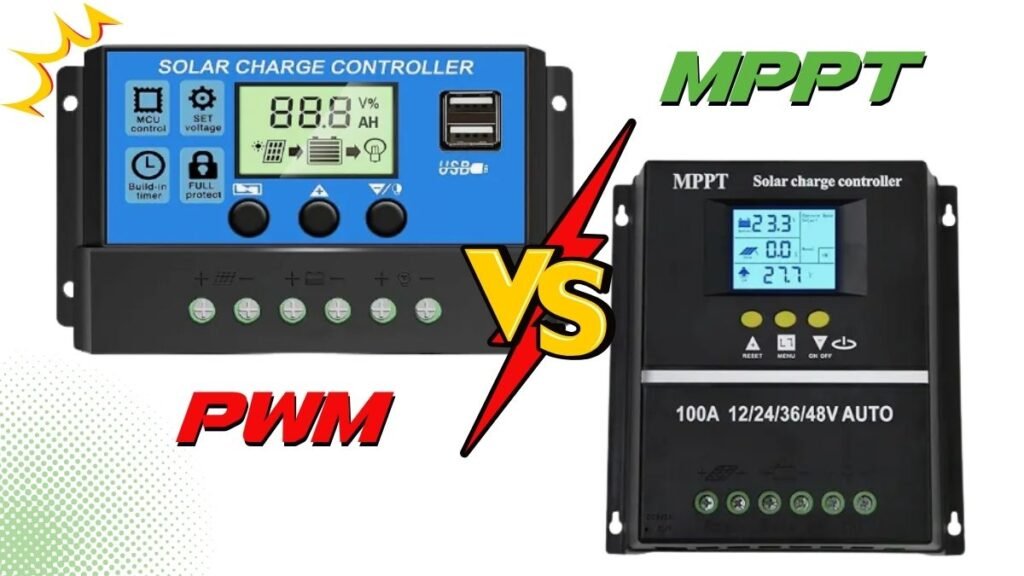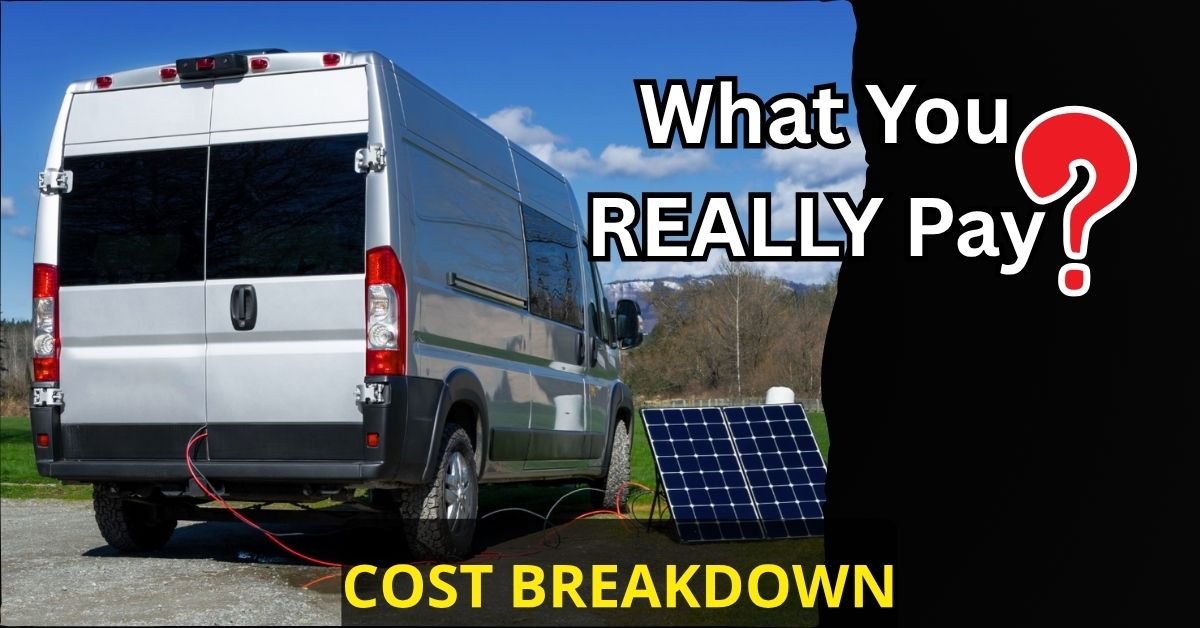“Comparison between PWM vs MPPT charge controllers for your solar setup. Learn the efficiency, cost, and best use cases to help you decide.”
Solar charge controllers are essential for protecting your batteries and maximizing energy harvest in off-grid or hybrid solar systems. But with two main types: PWM (Pulse Width Modulation) and MPPT (Maximum Power Point Tracking), how do you decide which is right for your setup?
This guide compares PWM and MPPT charge controllers in terms of efficiency, cost, compatibility, and real-world performance. Whether you’re powering a small RV or a large off-grid home, I’ll help you make the best choice.
What Is a Solar Charge Controller?
A solar charge controller is a critical component in any solar power setup. Its job is to manage how electricity flows from your solar panels to your battery bank, preventing overcharging, optimizing power delivery, and extending battery life.
There are two main types:
- PWM (Pulse Width Modulation): Older and simpler tech, more affordable, but less efficient.
- MPPT (Maximum Power Point Tracking): More advanced and expensive, but delivers higher efficiency, especially in variable weather or larger systems.
Let’s know more deeply-
PWM vs MPPT Charge Controller Guide
How PWM Works
PWM controllers work like a switch. They gradually reduce the amount of power sent to the battery as it nears full charge, “pulsing” energy in short bursts. Simple and effective, but they can’t adjust for varying panel voltages or maximize solar output.
Best for:
- ✔ Small 12V systems (e.g., RVs, boats)
- ✔ Tight Budget-conscious buyers
- ✔ Warm climates with consistent sunlight
Pros of PWM:
- Affordable
- Simple and reliable
- Good for small systems
Cons of PWM:
- Less efficient, especially with larger solar arrays
- Panel voltage must match battery voltage
- No optimization of power output
How MPPT Works
MPPT controllers are like mini-computers. They constantly adjust the input voltage to match the battery’s needs, ensuring maximum energy transfer. This tech is especially useful when solar panel voltage is much higher than battery voltage.
Best for:
- ✔ Large or high-voltage systems (24V/48V)
- ✔ Cold or cloudy environments
- ✔ Systems with panel voltages higher than battery voltage.
Pros of MPPT:
- Up to 30% more efficient than PWM
- Can handle higher voltage solar arrays
- Adapts to changing environmental conditions
Cons of MPPT:
- More expensive
- Slightly more complex
Comparison Table: Which Solar Charge Controller is Best, PWM or MPPT?
| Feature | PWM Charge Controller | MPPT Charge Controller |
| Efficiency | ~75–80% | ~94–98% |
| Cost | $20–$100 | $100–$600+ |
| Complexity | Simple | Advanced |
| Voltage Compatibility | Must match battery voltage | Can handle higher panel voltage |
| Ideal For | Small systems (<150W) | Larger systems (>150W) |
| Energy Loss | Higher | Minimal |
| Battery Charging Speed | Slower | Faster |
| Environmental Adaptability | Low | High |
| Lifespan | Long | Long |
| Pros | Affordable, simple, reliable | Efficient, flexible, adaptive |
| Cons | Less efficient, limited scalability | Expensive, complex |

Which One to Choose for What System
Choosing between PWM and MPPT comes down to your setup:
✅ Go with PWM if:
- You’re building a small DIY solar project (like a shed, RV, or boat)
- Your solar panel and battery voltages match (e.g., both 12V)
- Budget is your top concern
✅ Go with MPPT if:
- You want to squeeze every drop of power from your panels
- You live in a cold or variable climate
- Your solar panel voltage is significantly higher than your battery bank
- You’re running a large off-grid or hybrid solar system
Best Solar Charge Controllers on the Market (PWM and MPPT)
Here are some top-rated PWM & MPPT solar charge controllers that balance price, performance, and ease of use.
Top PWM Controllers:
- Renogy Wanderer 30A PWM 👍 Great for small RVs and campers
- Epever Tracer BN Series 👍 Reliable and affordable for basic solar setups
Top MPPT Controllers:
- Victron SmartSolar MPPT 100/30 🙂 Excellent performance and smart features
- Epever Tracer A Series MPPT 🙂 High efficiency and durability
- Renogy Rover MPPT 40A 🙂 Budget-friendly option with good reviews
💡 Pro Tip: Always match your controller’s amperage and voltage ratings with your solar array and battery bank.
Quick Verdicts & Use Case Recommendations
- Renogy Wanderer 30A (PWM): Perfect for entry-level users powering lights, fans, or a small fridge on a budget.
- Victron SmartSolar MPPT: Ideal for off-grid homeowners or enthusiasts who need remote monitoring and maximum power efficiency.
- EPEVER Tracer MPPT: Great balance for intermediate users building a reliable solar system without breaking the bank.
FAQs: Choosing the Right Charge Controller
Q: Can I upgrade from PWM to MPPT later?
Yes, just ensure your system supports the voltage/current of the new controller.
Q: Is MPPT always better than PWM?
Not always. For small, voltage-matched systems, the gains from MPPT may not justify the cost.
Q: What size charge controller do I need?
Choose based on your solar array’s voltage and current output. Add at least 25% headroom for safety.
Q: Are MPPT controllers harder to install?
Some models require basic configuration, but most come with user-friendly interfaces or apps.
You can read: 5 Best Solar-Powered Security Cameras.
Final Thoughts & Recommendation
When it comes to PWM vs MPPT charge controller , the right choice depends entirely on your system size, budget, and long-term goals.
- For beginners and small-scale users: PWM is the way to go.
- For serious off-gridders, homeowners, and solar enthusiasts: MPPT offers better value and performance over time.
No matter which one you pick, investing in a quality controller will protect your battery bank and ensure your solar system runs smoothly for years.
Need help deciding? Check current prices and full reviews below:
🔗 Best MPPT Controllers
Got questions? Drop them in the comments, I’m happy to help! 🚀










